| |
"Based on Joy Adamson's autobiographical account of life and wildlife in Kenya, the experience of making the film seems to have profoundly affected everyone involved, for, like his human stars Bill Travers and Virginia McKenna, Hill thereafter seems to have lost interest in any subject other than animals..." |
| |
The Independent newspaper's 1994 obituary for director James Hill* |
Africa does that to you... More on those extraordinary experiences very soon. Born Free is a movie very much of its time. A full maned lion stalks on a human-made track in the bush. Women and children from a nearby village are washing clothes. As most move back to their dwellings, one woman remains. The lion strikes. A few score gallons of blood wash away down river... Now, I usually trust Wikipedia to a degree so I hope it's just a blip that this event was described thus; "...after the lion scares a native villager." Scares? Try 'disembowels and consumes'. That was a lot of blood. Game warden George Adamson and his wife Joy are living in the part of the African continent they always loved, the wilds of northern Kenya. George has to kill the man-eating lion and after being attacked by a nearby lioness, he kills her too (not a great start for a conservation film). He finds out that the lioness was instinctively protecting her offspring. The three orphaned cubs are removed from the wild by George and Joy falls for the runt of the litter whom she christens Elsa, probably the most famous lion in the world apart from Simba who doesn't count with all due respect to Matthew Broderick. The thrust of the story is that while the other two bruiser cubs get shipped to a zoo in Holland, the couple cannot part with Elsa. But lions grow up and after an elephant incident for which Elsa was blamed, George and Joy have to habituate their 'friend' back into the wild or ship her off to a zoo as well.
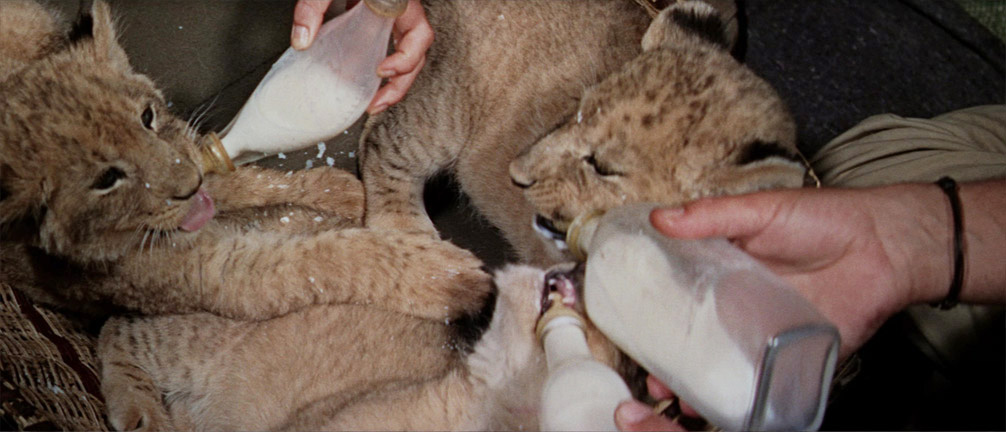
The story still resonates strongly as it's impossible not to care for Elsa (or rather the number of lions playing the part) almost as much as her adoptive 'parents' do. And regardless of the Cohen Brothers blurring the ethics of confirming what's true and what's not with Fargo, (both film and multiple TV series) the fact that this is actually a true story really helps. For further enlightenment on what's true and what simply isn't, check out the commentary. And who on Earth would not want a lion cub for a pet? OK, maybe most of us but as a child, I adored this kind of fantasy. Here, it was a reality and there are a few interesting precedents. Renowned Dutch natural history filmmaker Hugo van Lawick rescued a small wild dog puppy that could not keep up with its pack. After only a short while he introduced it to another pack that, amazingly, adopted it and didn't dismember and eat it, an intruder's probable fate. The Adamsons kept Elsa for years! The entertainment value of having a growing lioness plod around your home and garden like a rather intimidating but gorgeous pet is fairly high. We are just unused to seeing such animals in these habitats and the filmmakers have gone to some trouble to maximise the cuteness and the absurdity of three lion cubs on a laid breakfast table. This is where the film's conservation principles take a bit of a tumble. We are asked (as Joy does) to wholly give in to the specifically human desire for and attraction to these animals. Granted, they're both seductive passions but a true conservationist would have let the cubs die. It's sort of implied that in killing the man-eating male (dad) and its mate (mum) George feels responsible for the cubs' lives (the kids). As callous as the alternative sounds, you have to let the natural world be in all but a very few number of cases. The exception cited to this rule is usually if an unnatural event has changed something, you are honour bound to set it right again. You don't get more unnatural than a couple of bullets so perhaps George feels compelled to personally home the cubs. If he'd let them perish, then the world would have lost a very worthwhile conservation foundation created from the original book and movie's name. The Born Free Foundation is still going strong.
John Barry, a superb composer more famous for his work on the Bond franchise, was garlanded quite a bit for his rich, orchestral score and accompanying popular song. In fact he's the only composer to date to have won two Oscars for his score and end title song for Born Free. The score works for the movie, no question (it's a trifle schmaltzy now) but age and familiarity have blunted me to the song's charms and now it seems like the anthem of unthinking sentimentality and rubs me up the wrong way every time. It's also ferociously tenacious as an earworm. Lyricist Don Black, whose other work leaves me reeling with delight sometimes, misfires here but hey, what's my opinion worth? The song itself was worth a fortune. I'm not alone in thinking this now but at the time the producers didn't even feature it in the first prints of the film. It was only when they were badgered by singer Matt Monroe and others did they relent and included an edited version of the song to go over the end credits to qualify for the Oscars.
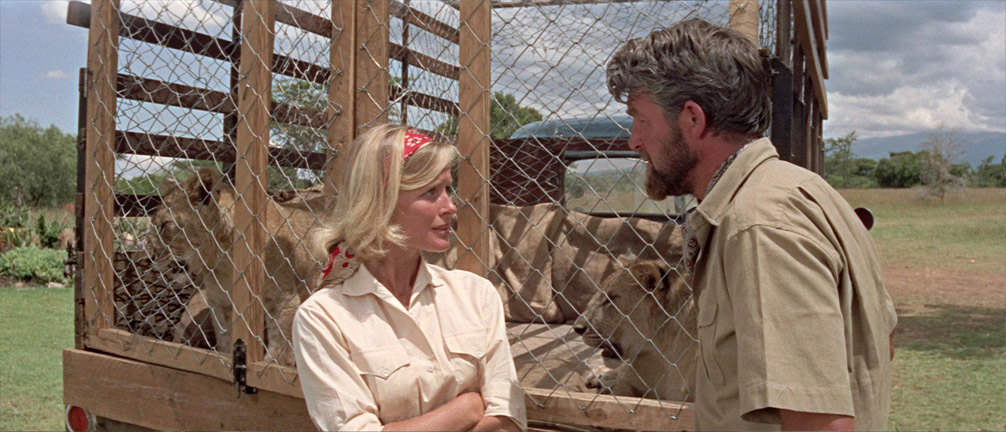
There were very good reasons that Born Free ended up with me. Here at Outsider, our own personal characters and experiences act as the prism through which we champion films (or extremely rarely, actually criticise). In reviewing Born Free I am faced with a multitude of connections between the subject matter and myself. It's not lost on me at all that I am writing this during a hiatus in the post-production of a desert lion film I'm editing in Vienna. I know what a profound effect an African wildlife experience can have on someone as I've had my unfair share. And the most profound was with lions. You become extraordinarily aware of your heartbeat and just being thrillingly alive as you stand in a land rover watching a lioness in long grass twenty yards away partially hidden from a line of zebras marching towards her. The resulting kill and our capturing of it with two film cameras and sync sound remains the defining moment of my professional life and the film crew left Africa bonded together in ways that precious few get to experience. I'm not glamourising lion kills. I was there to do a job and unfortunately action was and still is the primary currency in the world of natural history filmmaking. Hence the word movie directors use to kick start a scene. So I've had some experience, not a great deal but some in this area.
People of my own age will remember how Africa was presented to us via that glass-fronted box in the corner of the room. Through the series Tarzan and Daktari, we learned that it was always sunny in Africa, wild animals can be your friends and that for some reason white people seemed to do all the cool stuff and black people ran around after them. I remember Born Free's Elsa story and finding out from primate researcher Jane Goodall that chimpanzees killed and ate each other; so much for the vegetarian peaceniks. My animal education changed gear when I joined a wildlife production company in the 80s. My own world had been cinema and TV up to that point. The natural world nudged me hard in the ribs. When I finally got to the 'dark continent' as a producer/director, I worked from a tented camp and indeed, the colour separation was all too real, when it came to living quarters. Far from being an ingrained signifier of casual racism, it was explained to me that both black and white were more comfortable having their tents among their own cultures, their own spaces. Black and white worked together and ate together with no problem but there was no doubt who was in charge and that had more to do with where the money was coming from more than anything else.
Unintentionally I'm sure, but Born Free reinforces this quasi-colonial aspect to Africa in the early days. I am not saying that the African characters were dismissed as subordinate in the film. They are not but the whiter than white heroes seen from a 2017 perspective does underline the slightly uncomfortable feeling that the educated European visitor is still 'massa'. I tried hard to see past that watching the film. In 1966 I probably wouldn't have thought twice about this. Virginia McKenna and Bill Travers play the Adamsons whose partnership and chemistry (and cut glass English accents) compliment each other perfectly. This is just as well and quite understandable as the actors were married to each other at the time. It's a compliment to both that they were so taken by the story, they hurled themselves headlong into conservation work themselves so a few bravos due there.
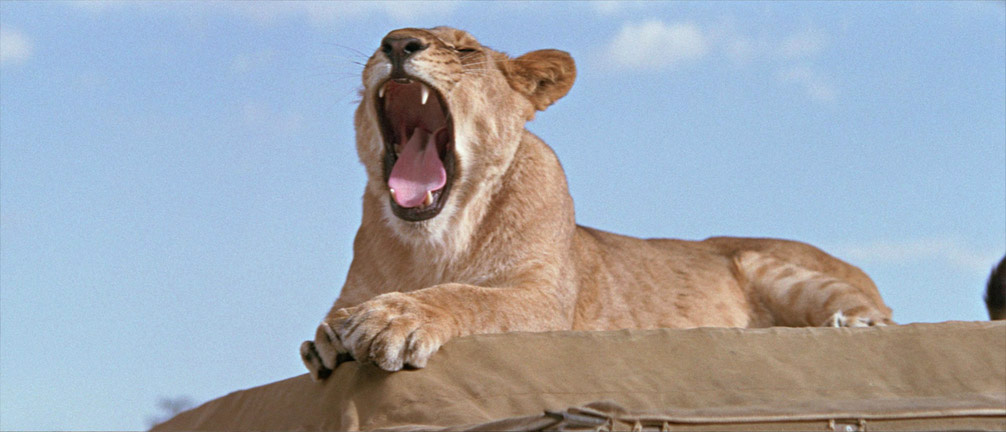
My heart goes out to editor Don Deacon. To cut animal footage well, you need a lot of good coverage. It seems to me that the crew shot mostly animals running away from the camera, which is, to be blunt, ethically unsound. If you are shooting an animal running away, it does not want you anywhere near it. These animal shots are cut into the main film when the spirit of Africa was needed, a reminder to the audience that we weren't in Shepperton studios even though we probably were quite a bit. Well, at least that fleeing giraffe wasn't. The charging elephants were clearly royally pissed off by the camera car, evidently driving away fast in one shot but it wasn't always obvious which shots were cut in from libraries characterised as they are by enhanced grain and lesser quality. Double-checking, it seems like some of the elephant shots have slightly increased grain. I think Deacon struggled with the elephant charge unless he got direction from James Hill to cut in elephants running left and then right and then left again. And right again several times. It was not so much a stampede, more of huge, grey case of perpetual indecision. To flop a shot in 1966 (to make right left and vice versa), all you had to do was turn the film over to indicate to the lab to print that particular shot through the base of the original negative. The loss of quality was not significant. A minor quibble. But the editing is noticeably off when the animals take centre stage. I know what it's like to not be able to craft something when you do not have the coverage. But that said, the sequence with Elsa and the warthog is outstanding in terms of unusual animal behaviour. And Deacon always had Joy and George to cut back to. I really don't want to know if that 'wild encounter' was set up. Or maybe I do. And here we come to the most ethically difficult aspect of what used to be merely a charming story of a married couple taking in orphaned lion cubs and managing to habituate one of them. If there was a constant reminder that the post-production crew knew nothing about lions, it was the ubiquitous roaring. I was over-roared. There's a series of obvious yawns from Elsa laying on top of the Land Rover to which a relentless number of loud roars were added. Lions are quiet animals. They stalk prey silently. The first lioness to get killed announces her arrival very loudly allowing George to get off a shot. It's not a complaint as such because movies have to be dramatised but really, a little research maybe? Yes, the opinions of the number of people who switched off the film after the first wolf attack in The Grey with Liam Neeson have worn down my initial enthusiasm for the movie. Why? Because wolves simply don't attack people. I tried to counter with the wolf being a metaphor for something (Liam's grief at losing a wife?) but even I don't support that anymore. It was like making a serious film about a killer jackrabbit.
At the heart of my issues with the film is this; Born Free suffers a little from having to practically do what the movie itself is telling us never to do. In order to shoot this story, the filmmakers had no access to Life of Pi CG animal wizardry. That tech was half a century away. They had to do it for real which meant using real lion cubs and grown lions. And if that's the case, you have to believe some of the sequences of animal behaviour were set up and that's deeply divisive. I'm not talking about watching young lions cavort around the house or pulling washing lines down. I'm more concerned specifically about lioness on lioness savage violence. Animals do not fake that. I know our human characters were visibly anguished watching it themselves (as was I) but that doesn't absolve the filmmakers. There appears to be repeat action from another angle that leads me to believe that there were two cameras so the violence was expected, engineered, encouraged. At the time, when we weren't so sensitive about such stuff, perhaps it was acceptable to set up a potential fight to the death. Do that today and they'd be, as Amity Island's Mayor Vaughn delightfully suggests, "...hung up by their Buster Browns!" Look at the furore over that American dentist who bagged himself a very famous lion.
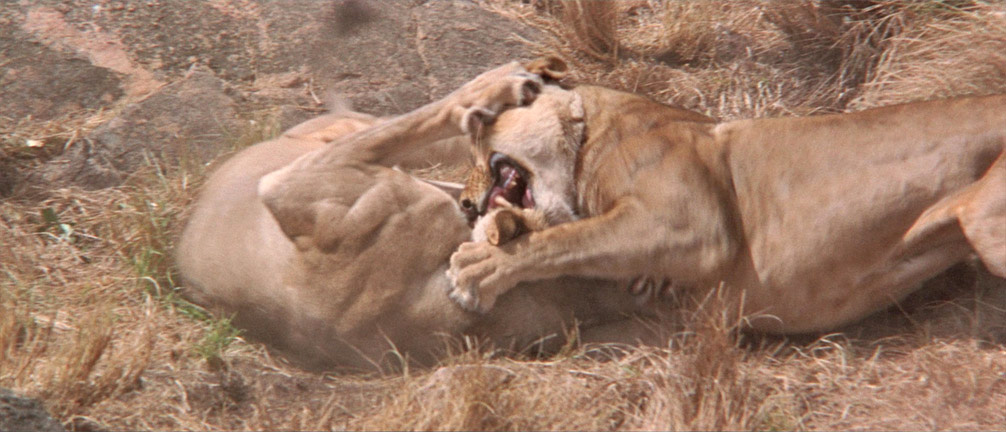
Leading filmmakers in the natural history world have been booed at festivals because they had been accused of stirring up animosity and violence for the sake of a great shot or fifty – the same shots the industry demands. The genre's desperate need for action and animal violence has presented the natural world in such a skewed fashion in the last thirty years that it's going to take decades to change general public perceptions. Anyone who has witnessed the stupidest behaviours of tourists on safaris will tell you that we are constantly being lied to by our TV screens. I hope we're all aware that natural history films are stories constructed to elicit an emotional response? If that sounds like I'm being superior, forgive me. The stories are largely created in post-production and are as 'real' as any other movie. Because of the Attenborough effect, they have become the shining example of noble filmmaking but they're all after the tears, the smiles and the awe just like the rest of us and so 'truth' - as much as any shot or story can be true – is tweaked, re-ordered, re-coloured and shifted around on a timeline for your viewing pleasure. Yes, it's all about serving you. It doesn't help that unless you are Planet Earth, budgets and schedules have all been drastically cut so the filmmaker has to toe, touch and sometimes cross a line he/she would never usually go near just in order to get workable footage. It's nice to know there are still filmmakers out there who never cross that line.
Born Free has a rather wonderful reputation (94% on Rotten Tomatoes) and I think this is partly to do with older reviews and perhaps the great force for conservation that rolled in after its own wave had broken. And it's still an effective tearjerker. My only worry is that it has dated but not in a fashion sense but an ethical one. It's still an important part of film and conservation history and worth checking out but see it with 2017 eyes and you may be in for a shock or two. Those lionesses are fighting to the death. No movie is worth that.
The Blu-ray showcases the 2.35:1 aspect ratio 1080p version handsomely with a pleasing 'film-look'. I only use that term because of the journey that we are all collectively taking away from the use of actual film. The idea of its 'look' is still in use in the industry. As mentioned, there are a few library shots, or shots copied more than once from another source but you're never taken out of the film because of them. The colours are earthy and pleasing (this is Kenya after all or indeed, other bits of the huge continent) and the contrast levels are not high and the entire movie has a light aspect to it. That said, the scenes at night have crisper contrast levels but not without sacrificing detail unless this was the directorial intention (the approaching goat-eating lion springs to mind).

The original mono soundtrack is presented in a PCM stereo track and if the tracks were re-engineered to stereo, it's not obvious to me but all the audio is perfectly understandable (with these actors, how could it not be?) and I have to admit, the isolated M&E sounds pretty good too. There are English subtitles for the deaf and hard of hearing.
Isolated score track
Buy the CD! Actually, this has some significance as a stand-alone music track because according to the commentary ... (the review of which MS Word decided I ought to rewrite with an unusual crash and inexplicable loss of copy considering my autosave is set to 1 frickin' minute), the John Barry score was rushed and some mistakes were let through. Barry then demanded to be able to re-record the score for the LP. So, hey. Here's a real curio in film score history. The Matt Monroe performance is also different and according to commentary moderator, Nick Redman, better. Knock yourselves out.
Audio Commentary with author and record producer Jon Burlingame, film historian Julie Kirgo, and documentary filmmaker Nick Redman
For this, you'll have to bear with my general comments as I'm paraphrasing from lost notes and despite the commentary being entertaining and informative, I just do not have the time to go through it again. It's a commentary by an historian fan (very partial to the cuteness of the animals), a writer and record producer who wrote a biography on composer John Barry and documentary filmmaker Nick Redman, a honey voiced regular on the commentary circuit.
Now, be prepared, this commentary is only scene specific about three times and even then tangents follow. So that's a plus for us anti-fans of 'describing the action' commentary. Without question the central section where the trio cover the truth and the fate of all concerned in the true story is most revealing about what Hollywood does with a factual narrative. If you want to experience the movie in a pure, unsullied way, then do not listen to the commentary first. Every event is up for scrutiny and accusations of "Not true!" For a start the extraordinarily English Virginia McKenna plays the Austrian Joy Adamson, née Friederike Viktoria Gessner born in what was then Austria-Hungary and is now the Czech Republic. Events depicted in the film from the point of view of a happy marriage are anything but - but I won't reveal more. It feels almost distasteful given the exalted regard in which the film is held.
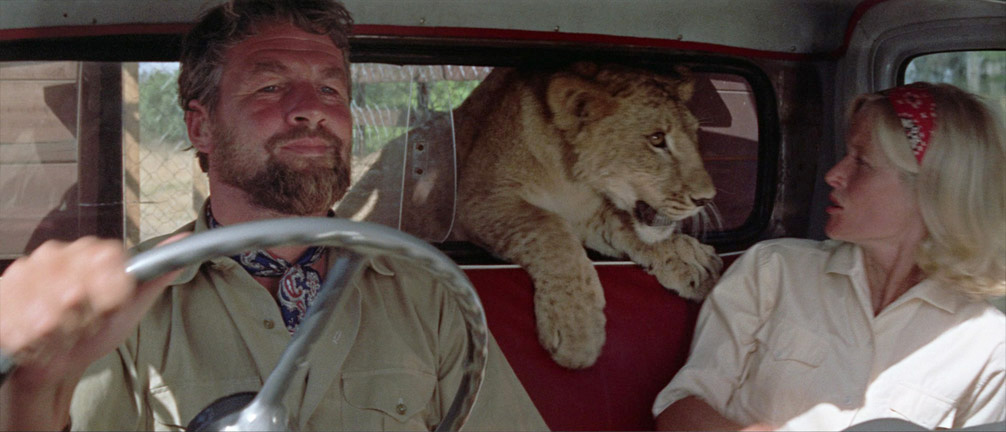
Composer John Barry is lauded often by all three and I still stand by what I've written in the review as to what a 2017 audience may make of his work. But it is true that most educated film music fans can spot a Barry score after two bars. I always thought that that was not necessarily a good thing as the idea of 'samey' comes to mind. But Jon Burlingame registers this as Barry's trademark and something that shouldn't be understood as it's part of the man's style and talent. OK. Leonard Rosenman is another composer whose work is usually swiftly identifiable. It must be common choice of instrumentation and arrangement.
The trio talks over the most controversial part of the film in my eyes without any reference to it at all (the savage lionesses fight). I rather hoped they'd mention it in passing but they simply let it run while they covered another topic. Regardless of this small niggle, this is a good commentary with some great background information and comes recommended.
Born Free Foundation - Spirit of Elsa (Meru Lion Census) (17' 40")
Will Travers (son and heir to his father's legacy) introduces us to the Meru lion census and the sorry fact of the dwindling numbers of lions over the last two decades in the national park. There are various ways to count lions, finding their footprints, or spoor, and enticing them in with recorded calls of prey in distress. Poaching is a big problem. Travers accompanies a poaching team that is trying to rid the bush of snares, metallic hoops that close in around a throat or a limb. I had some eerie jolt of recognition as I did just the same thing with an anti-poaching team twenty years ago. I remember the hot, uncomfortable hike to the poachers' den like it was yesterday. The team's aim was to burn the illegal bounty. They piled the skins and wooden frames high on to a bonfire and then sheepishly told us that none of the team had brought matches. To add to the unintentional comedy of the moment, I asked (as each member of the team was armed with an AK-47 automatic weapon) if there had been any causalities in their dealings with poachers. "Just the one..." came the reply... One of the team members, cleaning his weapon, had killed himself unintentionally. That's a conversation stopper.
Born Free Foundation – Elsa the Lioness Rescue (5' 44")
This is an Italian zoo rescue of a lioness called (what else but...) Elsa, another Born Free Foundation initiative. We are left in a legal limbo as far as the fate of the poor lioness is concerned.
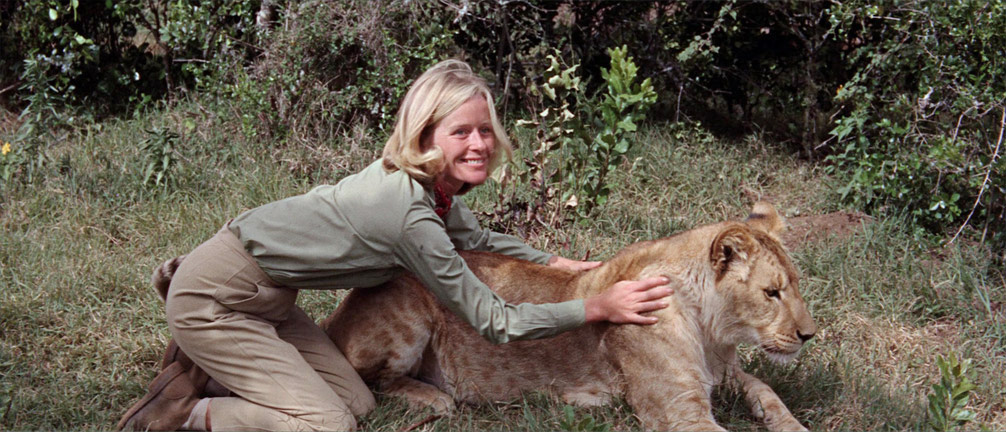
Born Free Foundation: 2016 Promotional Video (2' 27")
This one's a real curio. I have no doubt that the Born Free Foundation is doing fantastic work in reducing the suffering of all animals wherever they find them in distress. There are no captions of participants' identities but I assume an older Virginia McKenna is the first talking head. Weirdly, Peter Andre turns up to make a profound observation (that we should do what we can to alleviate animal suffering). Absolutely. And then, saying goodbye to Simba is someone who looks like the spittin' image of producer Lynda Obst. All faces are intercut with the logo-ed land rovers doing their thing. As a promo for the Foundation's work, this could be a lot punchier and informative.
Theatrical Trailer (3' 22")
"Filmed entirely in Africa!" Lying bastards! Unsettling to see the lionesses' fight in the trailer... This is a soft sell because who the hell doesn't want to see lions brought up by humans?
Teaser Trailer (1' 00")
Essentially a cut down version of the above with a terrible cut just before the relevant line "She was born free and has the right to live free..."
Born Free is a genuine classic but a film of its time that may not make such an easy transition into modern day appreciation. It's made with a heartfelt message but by using real lions it has to be part of the problem it's campaigning against. It's emotional to watch and at places a real tearjerker and liberal with the true events but hey, it's Elsa and we all fell in love with Elsa...
|